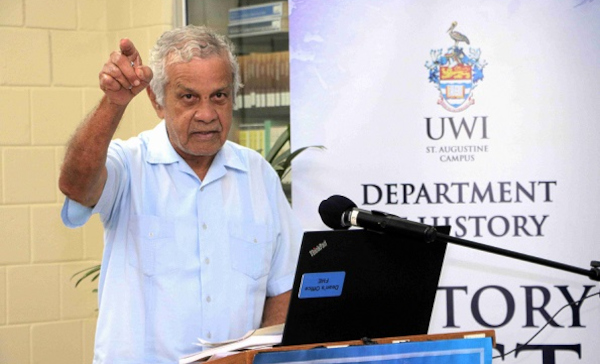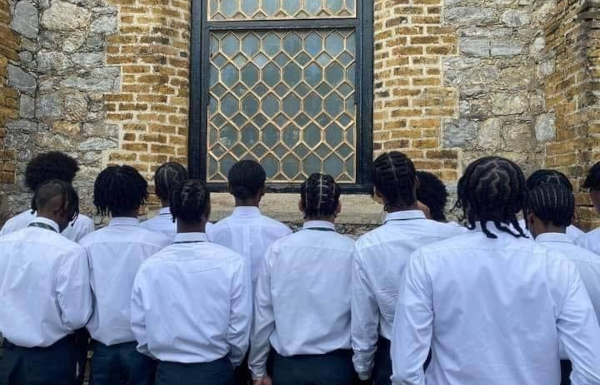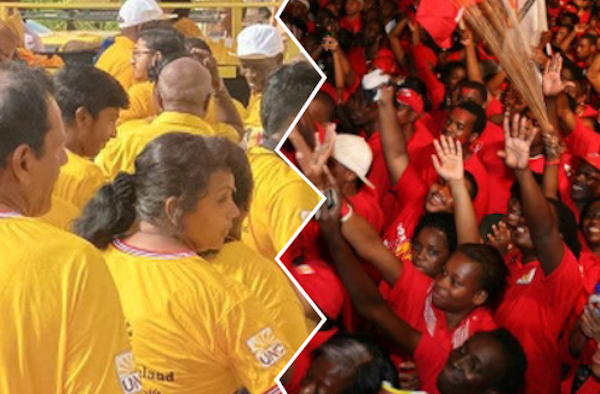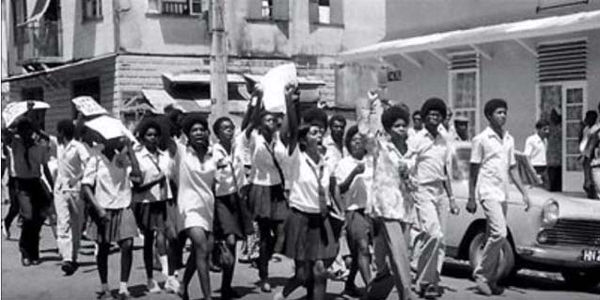“[…] Another key claim that NJAC always makes is that, because of Black Power, banks were forced into hiring non-white persons. It is true that, after the 1970 protests, banks did diversify their hiring practices. But […] this was just an acceleration of a process that had already started…”
In the following letter to the editor, author and satirist Kevin Baldeosingh claims that several of the gains claimed by the ‘Black Power’ movement are ‘historical distortions’:

(via Kevin Baldeosingh)
In an article published to mark the 50th anniversary of the Black Power protests, the National Joint Action Committee (NJAC) asserts that: ‘such was the spread of love that was generated across the nation that the crime rate went down by a record 56 percent in 1970’. This romantic claim, even if it were true, is empirically unprovable.
As it turns out, however, it is not true. As the table below shows, crime totals in selected categories showed statistically insignificant declines between 1969 and 1971. And, given the state of emergency imposed from April to November in 1970, this means that the overall crime rate was actually higher in that year.
Another key claim that NJAC always makes is that, because of Black Power, banks were forced into hiring non-white persons. It is true that, after the 1970 protests, banks did diversify their hiring practices. But, as I note in my new book on Trinidad’s history which is available on Amazon, ‘From Colony to Curse: A Social and Economic History of Trinidad 1901-2001’, this was just an acceleration of a process that had already started.
In 1967, Scotiabank—which, as the Express notes in its editorial of 25 April 2020, was one of the institutions attacked by Black Power activists—was running full-page newspaper ads with a photo of the manager of its Arima branch, Ronald A Chan.
Moreover, loans and mortgages were increasing at a rate that required more staff than could be drawn solely from the minuscule white or even Chinese populace in Trinidad, with a tenfold increase in personal loans that reflected a new non-white customer base.

Although NJAC says it stood for racial unity, the organisation focused most of its rhetorical attacks on white people. This perceived antipathy led to significant emigration among this group after 1970, with a 14 percent drop in their numbers by 1980.
But a 1970 survey conducted by the St. Augustine Research Associates (SARA) headed by Dr Selwyn Ryan found that ‘contrary to what our black power advocates preach, a significant majority of our respondents do not believe that whites oppress blacks’, with 60 percent of persons thinking otherwise.
As for social changes after 1970, it is difficult to trace any specific effects. This is largely because the 1973 oil boom totally disrupted the trends of the previous decade. But one significant change was an increase in births to unmarried women—a phenomenon that also started in the black urban community in the 1960s in the United States, from which NJAC’s leaders learned their Black Power ideology.
Between 1971 and 1977, the illegitimacy rate in Trinidad and Tobago went from 42 percent to 44 percent, although this rate had been declining steadily since the 1950s. This hike occurred even as the birth-rate per 1,000 women 15-49 years old went down from 113 to 102 per 1,000 and the marriage rate increased from 13 per 1000 to 16 per 1,000.
These figures are odd because marriage rates in Trinidad had previously gone up only in times of socioeconomic uncertainty, such as the two world wars and the Great Depression. Also, if marriage rates were going up, the illegitimacy rates should concomitantly have declined even further.

(Courtesy Embau Moheni/NJAC)
The simplest explanation is that the figures are statistical artefacts—that is erroneous. However, if the statistics were accurate, certain social implications arise from the apparent contradictions.
There are three main possibilities: (1) Marriages only increased among a particular cohort, most likely middle-class Afro-Trinidadians; (2) women from this same cohort started having fewer children and/or women from the lower socio-economic bracket started having more children; (3) more married men started having affairs and so more women had more children out of wedlock.
It is noteworthy in this regard that legitimate births increased by just three percent between 1971 and 1977, whereas illegitimate births rose by 12 percent. So, contrary to the historical pattern, married women were now having fewer children than unmarried ones. This was partly a function of class, since women from the higher socio-economic brackets were more likely to be married and educated, and more education also correlated with fewer children.
At any rate, this new demographic pattern had significant negative effects on the Afro-Trinidadian community. Whether this was an outcome of Black Power or not remains an open question.
Editor’s Note: Click HERE to read a retort from columnist Noble Philip who suggests that Kevin Baldeosingh did not show evidence that he read widely enough to properly understand the 1970 movement.
Want to share your thoughts with Wired868? Email us at editor@wired868.com.
Please keep your letter between 300 to 600 words and be sure to read it over first for typos and punctuation.
We don’t publish anonymously unless there is a good reason, such as an obvious threat of harassment or job loss.
 Wired868 Wired868 for smart sport news and opinion
Wired868 Wired868 for smart sport news and opinion







OVERSTATING IS A POLITICAL REALITY AND NO ONE GROUP IS IMMUNE-
All Political prescriptions have been found wanting even if one is against Marxism it is ironical that Marxist China is,
1) Net Lender to Capitalist USA.
2)Have been the go to guys to undercut the local Building Industry by both PNM and UNC.
3) NJAC was part of a Global Civil Rights Movement the likes of Martin Luther King and Mandela and even Gandhi who fought for the Under Class.
4) Yes many are dismissive of the role of even Williams, King, Butler, Mandela and Ghandi’
5) Williams was also accused of Marxist leanings but was preferred to Butler who was less polished and more radical.
Ironically where Capitalism has failed Mark-ism has succeeded and vice versa, Capitalist have no problems with cheap Marxist Labour and Marxist have no problem lending to Capitalist countries it is a marriage made in heaven.
We keep getting this absolute nonsense about the gains of Black Power by delusional folks like Raffique Shah and the NJAC leadership themselves. I will address the main ones briefly.
1) The Black Power movement had wide support among black people of all ages and classes and areas. No sah it wasn’t so. The vast majority of its supporters were black youth, mostly males, and from the East-West corridor. Those like me who attended marches and meetings in 1970 saw very few of the parents and grandparents who generally remained staunchly loyal to the PNM. We saw very few females of any age. Most of the marches and meetings took place in the East West corridor, and very few big ones happened in central, east, south or deep south.
2) The alleged flowering Afro-Indian racial unity beloved of Shah et al is an even more jokey myth. Let me tell you, friends, that I was at UWI St Augustine when the Joint Action Committee a campus group with little or no support left there to find more power on the streets. I can say categorically that I saw not a single
Indian of the hundreds on campus join the Black Power gang. The marches and meetings had nary an Indian to be seen. Even on the march to Caroni Indians welcomed the black marchers as advised by Bhadase Maraj but did not join the march, which failed in its stated purpose to get exactly that. And who were the masses of Indians claimed to have joined NJAC? Josanne Leonard and Rajah Ramlogan don’t make much of a regiment.
3) The gains in employment of black people in white businesses were no more than window dressing and pappyshow. NJAC’s aim of nationalizing the commanding heights of the economy for black people and getting said black people in ownership or control of those while businesses never happened. Sure the white business class hired a few black people to be tellers in the banks, the least important positions mind you, and as minor functionaries in other businesses but kept the positions of power for themselves. How many black people went into business for themselves after 1970? Count them on fingers and toes. How many became managers and directors and CEO’s? Woo boy this is embarrassing.
4) So why didn’t the commanding heights of the economy fall into eager black hands? Because the commanding heights of the economy were ALREADY in the hands of black people! NJAC was so stupid they were fighting for something they already had. Eric Williams as corporation sole on behalf of his mostly black PNM members, had all the money in the treasury in his hands. Including the billions of oil revenue that made up at the time over 70% of the country’s income. Oil and gas was the commanding heights of the economy, not a few white businesses around Port of Spain. Those businesses and the oil companies did not control Trinidad and Tobago. Eric Williams and the PNM government did. What do I have to do for NJAC to understand they were trying to climb a greasy pole when the ham was already in their hands? I am sure the white businessmen came bleating to Eric Williams saying what we go do, them Black Power kids want to take we business! And Eric Williams would have said don’t worry, just hire a few of my people and put them in the front window, your businesses are safe. You think I want to nationalize your business like Fidel Castro in Cuba? Look at what happen to him? The marines will invade Trinidad. I would never have the money to pay you guys off if I decide to nationalize that way. And too besides, white business people are nationals! How I could nationalize the business of a national, just because of his race? And what about them Indian business owned by nationals? i should nationalize Seereram Brothers and Maraj Jewellers too, right?
4) You know something? Raffique Shah and the NJAC gang still haven’t learned the lessons of 1970. Raf remains an unrepentant Marxist still looking for the working class proletariat to seize the commanding heights of the economy. NJAC still can’t understand why they can’t win an election in any part of the country, including Laventille. Indians top to bottom don’t want to hear them. Two generations of black youth have deemed them irrelevant, and the PNM still commands the electoral support of over 90% of black people. Let’s face it, NJAC had only one weapon in the impromptu marches and when they can’t march they have nothing. They never had a chance of achieving racial unity in 1970 and they have less than zero chance today. Time to give it a rest, fellers. And that goes double for Raffique Shah, who was even more stupid than NJAC in 1970 that he didn’t even know imprisoning his superior officers and taking an armed detachment towards the city was mutiny and sedition, punishable by death. The idiot thought he was going to negotiate better working conditions for his soldiers, a trade union matter, and was tricked into giving up his weapons and taken prisoner. I believe in freedom of expression and press freedom, but I’m willing to make an exception for the loony lieutanant Raffique Shah!
“NJAC still can’t understand why they can’t win an election in any part of the country, including Laventille. Indians top to bottom don’t want to hear them. Two generations of black youth have deemed them irrelevant, and the PNM still commands the electoral support of over 90% of black people”.
Salient points!